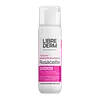What's inside
What's inside
 Key Ingredients
Key Ingredients

No key ingredients
 Benefits
Benefits

 Concerns
Concerns

 Ingredients Side-by-side
Ingredients Side-by-side

Water
Skin ConditioningGlycerin
HumectantCocamidopropyl Betaine
CleansingLauryl Glucoside
CleansingPanthenol
Skin ConditioningSodium Lauryl Glucose Carboxylate
CleansingCocamide Mipa
EmulsifyingCoco-Glucoside
CleansingSodium PCA
HumectantC12-15 Alkyl Benzoate
AntimicrobialSodium Benzoate
MaskingChamomilla Recutita Flower Extract
MaskingAloe Barbadensis Leaf Extract
EmollientPotassium Sorbate
PreservativeHydrolyzed Wheat Protein
Skin ConditioningHydrolyzed Soy Protein
HumectantHydrolyzed Corn Protein
Skin ConditioningTetrasodium EDTA
Water, Glycerin, Cocamidopropyl Betaine, Lauryl Glucoside, Panthenol, Sodium Lauryl Glucose Carboxylate, Cocamide Mipa, Coco-Glucoside, Sodium PCA, C12-15 Alkyl Benzoate, Sodium Benzoate, Chamomilla Recutita Flower Extract, Aloe Barbadensis Leaf Extract, Potassium Sorbate, Hydrolyzed Wheat Protein, Hydrolyzed Soy Protein, Hydrolyzed Corn Protein, Tetrasodium EDTA
Water
Skin ConditioningCocamidopropyl Betaine
CleansingGlycerin
HumectantSodium Cocoamphoacetate
CleansingHydroxyethyl Urea
HumectantSodium Cocoyl Glutamate
CleansingSodium Cocoyl Apple Amino Acids
Skin ConditioningSodium PCA
HumectantPolyglyceryl-6 Caprylate
EmulsifyingPolyglyceryl-3 Cocoate
EmulsifyingAllantoin
Skin ConditioningPolyglyceryl-4 Caprate
EmulsifyingCitric Acid
BufferingPolyglyceryl-6 Ricinoleate
EmulsifyingParfum
MaskingChlorphenesin
AntimicrobialMagnesium Nitrate
Methylchloroisothiazolinone
PreservativeMagnesium Chloride
Methylisothiazolinone
PreservativeButylene Glycol
HumectantVincetoxicum Atratum Root Extract
EmollientCornus Officinalis Fruit Extract
Skin ConditioningDimethyl Sulfone
SolventDipotassium Glycyrrhizate
HumectantTetrasodium EDTA
Water, Cocamidopropyl Betaine, Glycerin, Sodium Cocoamphoacetate, Hydroxyethyl Urea, Sodium Cocoyl Glutamate, Sodium Cocoyl Apple Amino Acids, Sodium PCA, Polyglyceryl-6 Caprylate, Polyglyceryl-3 Cocoate, Allantoin, Polyglyceryl-4 Caprate, Citric Acid, Polyglyceryl-6 Ricinoleate, Parfum, Chlorphenesin, Magnesium Nitrate, Methylchloroisothiazolinone, Magnesium Chloride, Methylisothiazolinone, Butylene Glycol, Vincetoxicum Atratum Root Extract, Cornus Officinalis Fruit Extract, Dimethyl Sulfone, Dipotassium Glycyrrhizate, Tetrasodium EDTA
 Reviews
Reviews

Ingredients Explained
These ingredients are found in both products.
Ingredients higher up in an ingredient list are typically present in a larger amount.
Cocamidopropyl Betaine is a fatty acid created by mixing similar compounds in coconut oil and dimethylaminopropylamine, a compound with two amino groups.
This ingredient is a surfactant and cleanser. It helps gather the dirt, pollutants, and other impurities in your skin to be washed away. It also helps thicken a product and make the texture more creamy.
Being created from coconut oil means Cocamidopropyl Betaine is hydrating for the skin.
While Cocamidopropyl Betaine was believed to be an allergen, a study from 2012 disproved this. It found two compounds in unpure Cocamidopropyl Betaine to be the irritants: aminoamide and 3-dimethylaminopropylamine. High-grade and pure Cocamidopropyl Betaine did not induce allergic reactions during this study.
Learn more about Cocamidopropyl BetaineGlycerin is already naturally found in your skin. It helps moisturize and protect your skin.
A study from 2016 found glycerin to be more effective as a humectant than AHAs and hyaluronic acid.
As a humectant, it helps the skin stay hydrated by pulling moisture to your skin. The low molecular weight of glycerin allows it to pull moisture into the deeper layers of your skin.
Hydrated skin improves your skin barrier; Your skin barrier helps protect against irritants and bacteria.
Glycerin has also been found to have antimicrobial and antiviral properties. Due to these properties, glycerin is often used in wound and burn treatments.
In cosmetics, glycerin is usually derived from plants such as soybean or palm. However, it can also be sourced from animals, such as tallow or animal fat.
This ingredient is organic, colorless, odorless, and non-toxic.
Glycerin is the name for this ingredient in American English. British English uses Glycerol/Glycerine.
Learn more about GlycerinSodium PCA is the sodium salt of pyroglutamic acid. It is naturally occurring in our skin's natural moisturizing factors where it works to maintain hydration.
The PCA stands for pyrrolidone carboxylic acid, a natural amino acid derivative.
This ingredient has skin conditioning, anti-inflammatory, and humectant properties. Humectants help hydrate your skin by drawing moisture from the air. This helps keep your skin moisturized.
Learn more about Sodium PCATetrasodium EDTA is the salt formed from neutralizing ethylenediamine tetraacetic acid with sodium hydroxide. It is a chelating agent and used to prevent metal ions from binding to other ingredients. This helps keep the product and ingredients stable.
Tetrasodium EDTA comes as a white solid and is soluble in water.
Water. It's the most common cosmetic ingredient of all. You'll usually see it at the top of ingredient lists, meaning that it makes up the largest part of the product.
So why is it so popular? Water most often acts as a solvent - this means that it helps dissolve other ingredients into the formulation.
You'll also recognize water as that liquid we all need to stay alive. If you see this, drink a glass of water. Stay hydrated!
Learn more about Water